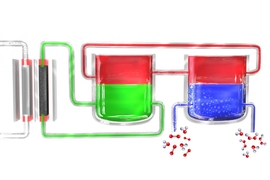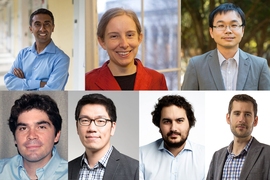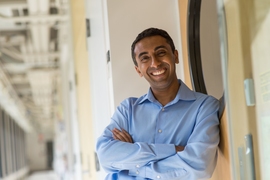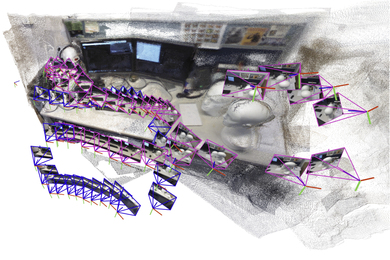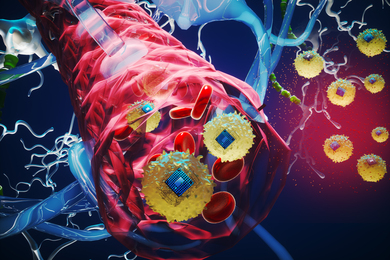When Sneaky the Lizard received his PhD in chemistry from MIT, an enthusiastic team of researchers in the lab of Yogesh “Yogi” Surendranath was there to celebrate. Although Sneaky is just a fictional, photoshopped character, he’s an important part of the lab culture, and his “graduation” was akin to a family milestone.
“Sneaky the Lizard graduated in 2018, despite never showing up to work,” says Surendranath, the Paul M. Cook Career Development Associate Professor of Chemistry, while proudly showing off a lab photo with Sneaky up-front and center. “My group is so weird, but I love them so much.”
The Surendranath lab is a tight-knit group that enjoys a lot of inside jokes — about mangoes and coconuts, as well as imaginary lizards. But it’s also about groundbreaking work in electrochemistry that is opening up new paths to a low-carbon future.
Those who work in the lab say the two are related.
“At the end of the day, we work on really, really hard problems, and in order to work in that environment and stay sane, you need a culture that’s supportive and makes it fun and exciting and interesting,” says Surendranath, who this summer received a Presidential Early Career Award for Scientists and Engineers, the highest honor the U.S. government gives to outstanding scientists and engineers beginning independent careers.
“We’re one community wherever we are, and we all take pleasure in solving these problems at the electrochemical interfaces,” says postdoc Marcel Schreier. “This allows us to be a little bit ahead sometimes. We ask more questions and try and try and try to answer them.”
All of the work in the Surendranath lab centers on using electricity to rearrange chemical bonds — fundamental scientific research with a host of possible applications. A key focus is finding ways to make carbon dioxide (CO2), a major greenhouse gas, useful — research central to addressing climate change. Surendranath, who serves as the associate director of the Carbon Capture, Utilization, and Storage Center, one of the Low-Carbon Energy Centers run by the MIT Energy Initiative (MITEI), says, “Our whole group works on the grand challenges MITEI undertakes on the low-carbon future of energy.”
A wealth of applications
Already, the Surendranath group has made major advances in the design of catalysts for converting CO2 into carbon monoxide — work that holds promise for one day using renewable energy to turn CO2 emissions into high-quality fuels. The lab has also developed a new graphite-based catalyst that could potentially replace expensive and rare metals in fuel cells.
“Our work is so fundamental, there isn’t a specific application we’re targeting. Batteries, fuel cells, any electrochemical transduction technology is going to have an interfacial question that we’re hoping to address,” says postdoc Michael Pegis.
Interestingly, the 18 members of the lab tackle many different kinds of questions within the broad spectrum of electrochemical research. While Pegis works on how electric fields influence the rate of bond-breaking and bond-forming reactions in oxygen reduction reactions — work that could improve fuel cells, for example — Jonathan “Jo” Melville, a PhD candidate and Tata Fellow, is researching nitrogen fixation for fertilizers in an effort to find a less energy-intensive way to produce food.
“Nitrogen is key for feeding billions around the world,” Melville says, noting that without nitrogen-rich fertilizers, there would not be enough arable land on earth to feed the population. Since the current system of production uses fossil fuels, generating roughly 2 percent of anthropogenic CO2 emissions, Melville is hoping to develop a sustainable alternative process. “I went into chemistry because I really care about solving the energy crisis,” he says.
Schreier’s work takes on the challenge of reaching a low-carbon future from another angle. He focuses on the catalytic capabilities of copper in the hope of finding new ways to store energy chemically — work broadly applicable to the challenge of improving the storage of energy generated by such intermittent sources as solar and wind.
PhD candidate Soyoung Kim, meanwhile, works to make useful chemicals from natural gas using metal-ion catalysts driven by electricity — a method she says could make it possible to sustain the reaction with energy from renewable sources.
For lab members — including specialists in inorganic chemistry, physical chemistry, chemical engineering, and electrochemistry — the wide variety of work taking place in the lab expands the opportunities for useful collaboration. “There’s so much knowledge in so many fields, I’ve been able to learn about new things — like computational chemistry from a postdoc who sits behind me,” Pegis says.
Surendranath deliberately fosters this synergy through regular team meetings as well as off-site activities such as hiking trips and retreats. “I think of science as a gift economy,” he says — with each researcher giving the gift of time and skills to other lab members in full expectation that similar gifts will be returned.
“We help each other all the time, informally,” Schreier says. “If someone has a problem, they will start drawing on the white board, and everyone will chime in and offer solutions.”
This esprit de corps carries through to everyday lab chores. There is no lab manager in the Surendranath lab; responsibilities are shared by the team, with individuals taking on such jobs as overseeing safety procedures, caring for particular instruments, ordering solvents, and organizing cleanups. Recently, the group worked in shifts to bar-code 35,000 chemicals. “In some cases, a lab manager can be useful, but it can be good to get together to make sure the lab is a cleaner and safer place,” Pegis says.
“We have lab tasks,” Schreier explains. “This works quite smoothly.”
Lab members also make their own hours and work out disputes among themselves. “I give my students enormous freedom,” says Surendranath, who was recently awarded the Nobel Laureate Signature Award for Graduate Education in Chemistry from the American Chemical Society, together with his graduate student Anna Wuttig PhD ’18. (Wuttig is now a postdoc at the University of California at Berkeley.) “All I care about is that they care about the science and do great work,” says Surendranath.
Mangoes, kites, and coconuts
With so much independent thinking, it’s perhaps not surprising that the word “quirky” comes up a lot when members are asked about the lab.
“Yogi is very supportive and approachable as a boss, while super-energetic and engaging when it comes to discussing science. That has attracted many hard-working and sometimes quirky people to the lab,” Kim says.
“It’s definitely a very quirky group of people,” Pegis agrees.
Indeed, the description applies even to Surendranath himself, who is crazy for mangoes, fascinated by tumbleweeds, and passionate about kite-flying. Perhaps that’s why he built a team that supports each member — quirks and all.
Schreier tells a story to illustrate. The lab was on a hike together in the White Mountains and running behind schedule because Surendranath needed to bring a coconut with him — a lab tradition with somewhat obscure origins — and he had had trouble finding one. So, once the team reached the peak, everyone was eager to head back — except Schreier. He had spotted a radio tower (a passion of his) and could not resist dashing off for a closer look, delaying everyone.
When he got back, “the whole group, with Yogi in the center, was waiting for me very patiently. It seemed to them the most normal thing that I would need to check out this transmitting tower,” he says. The experience really warmed Schreier’s heart and is one reason the team is so special to him. “It’s the way the group works. Everyone’s interests are taken seriously.”
Melville agrees, saying this depth of support has made it easier for him to cope with the pressures of grad school and noting that it all comes from the top. “Yogi sets the gold standard for proactive and ethical mentorship,” he says. “We love him.”
The feeling is mutual. “I love my people,” Surendranath says. “It is a true joy to interact with enthusiastic, like-minded, passionate people every day and engage with them on really stimulating problems … I think the culture day-to-day is more rewarding than the science, because you have an impact on people’s lives: how they mature.”
This article appears in the Autumn 2019 issue of Energy Futures, the magazine of the MIT Energy Initiative.


